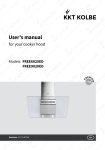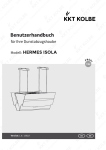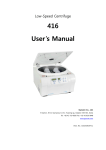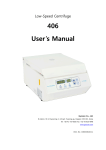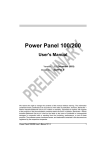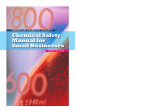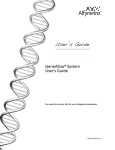Download User's manual - page screenshot of kolbe
Transcript
User’s manual for your island cooker hood Model: DRAFT900 P Version: 1.0 / 140714 UM REMI LINE EN Hints and symbols Dispose of the dishwasher packaging material correctly. All packaging materials can be recycled. Plastic parts are marked with the standard international abbreviations: (e.g. PS for polystyrene, padding material) This appliance is identified according to the European guideline 2002/96/EC on waste electrical and electronic equipment -WEEE. The guideline specifies the framework for an EU-wide valid return and re-use of old appliances. This icon indicates a hazardous situation. You‘ll find it especially with all descriptions of the steps that might cause danger to persons arising. Observe these safety instructions and behave accordingly careful. Enter these warnings also to other users of the device. ! This icon indicates a warning. You can find it in the description of the steps that must be observed in order to damage to the unit can be prevented. Please include these safety instructions to all device users. This icon indicates an information. This symbol indicates useful tips and calls attention to proper procedure and behavior. The observance of the notes marked with this icon may save you many problems. Safety informations • The device is designed for household operation and is to be used exclusively for that. • Installation must be performed by qualified personnel. • The device and the filter must be cleaned regularly in order to function properly received. Please refer to the section „Care and cleaning“. • Fat or oil filters represent large fire hazard. • The unit may only be cleaned when its powered off. • For cleaning inside the unit this must be disconnected from the mains. • Do not use open flame to clean the filter. • In case of malfunction of the device, the customer service is notified. Try to repair by no means the device itself. • Keep the room well ventilated, if they operate the unit for a gas stove. • The exhaust hose of the device must be installed in a separate exhaust stack to the outside. He may not be transferred by any other shafts or chimneys. • Read the manual / installation instructions before installing the unit thoroughly. • Check the technical data (V and Hz) on the rating plate of the device with which your house wiring. If these do not match, return the appliance to the place of purchase. In this regard ambiguities ask your electricity supplier. ! Accessible parts of the appliance may become hot when cooking devices are placed below. EN • Keep children away from the unit. The operation of the device by children is permitted only under adult supervision. Thank you! Congratulations on the purchase of your new cooker hood! We recommend that you spend some time to read this Instruction / Installation Manual in order to fully understand how to install the appliance correctly and operate it. For installation, please read the installation section. Read all the safety instructions carefully before use and keep this Instruction / Installation Manual for future reference. User’s guide Down-Draft cooker hood DRAFT900 Version 1.0 © 2014 KKT KOLBE Küchentechnik. KKT KOLBE is a registred trademark. 4 Table of content 1. General notes 1.1 Intended use 1.2 Protection of the environment 1.3 Tips and general advice 6 2. Before using the hood 7 3. Using the hood 3.1 Operating safety information 3.2 In exhaust air mode 3.3 In circulation air mode 7 4. Care and cleaning 4.1 Changing the filters 4.2 Carbon filters 9 5. Changing the lamps 10 6. What to do if... 6.1 Customer support 11 7. Installation 7.1 Installation data 7.2 Using the extractor hood as an exhaust air hood 7.3 Converting the extractor hood to a circulation hood 7.4 Electrical connection 7.5 Mounting the carbon filter 12 8. Appliance components 14 9. Control panel 14 10.Troubleshooting 15 11.Informations on air flow 16 12.General installation instruction 12.1 Working modes 12.2 Installation 17 EN Overview 5 General notes 1. General notes 1.1 Intended use 1.2 Protection of the environment 1.2.1 Package ! The appliance is intended for domestic use. The manufacturer is not responsible for damage resulting from improper use or maloperation. Extractor hoods remove unpleasant odours and vapours and create a pleasant room atmosphere. Particles of grease, steam and also moisture are absorbed by the grease filter. A correctly dimensioned extractor hood creates a pleasant room climate without producing draughts and ensures a bearable air humidity of 40-60%. The packing materials are 100% recyclable. Comply with local regulations for their disposal. The packing materials (plastic bags, polystyrene moulded parts etc) are dangerous for children. So keep packing material out of the reach of children. 1.2.2 Disposal If this appliance is a replacement for an old one, please dispose of your old appliance according to the statutory regulations. Prior to disposal the appliance must be rendered unserviceable by cutting off the power supply cable. The appliance is to be sent for disposal to the responsible collection authorities. 1.3 General tips Make sure no open fire is burning in the fireplace before you switch on the appliance or there may be a heavy smoke formation in your home. Toxic combustion gases can also be drawn from the chimney or flue, into living rooms. This can be lethally dangerous! 6 ! a) Prior to carrying out cleaning or maintenance work the power supply to the extractor hood is to be cut off by removing the supply plug or tripping out or removing the fuse. b) The air extracted from the hood is not to be routed over the exhaust air pipeline General notes c) No flambé dishes are to be prepared under the extractor hood. The open flames could destroy the hood or even cause a kitchen fire. d) Never leave pans unwatched when frying because fat can easily catch fire. e) Constant maintenance guarantees problem-free operation and optimal hood performance. f) If the hood is used together with other nonelectrically operated appliances, the room partial vacuum must not exceed 4 Pa (4 x 10-5 bar). g) Make sure that the room is adequately ventilated. h) Regularly clean encrusted food from appliance surfaces. i) Regularly clean or replace the filter. 2. Before using the hood EN of the heater or other non-electric operated appliances. ! Ensure that the hood has not suffered damage during transport. Installation and connection of the electrical supply and the exhaust air must be carried out by experienced tradesmen according to the manufacturer’s instructions and in compliance with the local requirements. 3. Using the hood 3.1 Operating safety information ! ! The exhaust air hose must not be made from or contain flammable materials. • The grease filter must always be in place when operating the hood, otherwise grease vapour can become deposited in the hood and the exhaust air system. • With gas hobs, take care that hobs are not operated without cooking utensils. Parts of the hood can be damaged by the rising heat from open gas flames. • Flame cooking under the hood is not permitted due to the fire risk. The rising flame can set fire to grease deposited in the filter. 7 Safety 3.3 In circulation air mode • Due to the fire risk, frying or cooking with oils and fats under the hood is only to take place under constant surveillance. Attention! The risk of self-ignition increases with oils which have been used repeatedly used. ! Other activities with an open flame are not permitted. These could damage the filter or other parts of the appliance or even start a fire. The inlet air is filtered through a carbon filter (also known as active carbon filter) and circulated in the room. The carbon filter captures the odours produced through cooking. The filtered air is circulated back into the kitchen through air openings at the side or on the top. If the hood is used in circulation air mode, it is absolutely safe to simultaneously operate a room air-dependent fire. Switch on the appliance a few minutes prior to commencing cooking. 3.2 In exhaust air mode The extracted air is emitted outdoors via the exhaust hose. For this purpose your house must have an exhaust air shaft or an exhaust air pipeline leading outdoors. When using the hood in exhaust air mode and operating with chimney-dependent firing methods, (e.g. coal oven) care must be taken for an adequate supply of fresh air in the installation location. Always discuss this with your responsible chimney-sweeping specialist. If no permanently installed exhaust air pipeline or exhaust air shaft is available, you must operate the hood in circulation air mode. (see chapter 12.1) 8 It is recommended with both exhaust and circulation air modes to run the fan a further ca. 5 to 10 minutes after cooking. This will free the kitchen air of any remaining steam and odours. 1. For improved hood performance, pull out the steam collector (where fitted). 2. Set the fan speed according to the amount of smoke and odours to be extracted. 3. Operate the hood for another ca. 5 to 10 minutes after finishing cooking. 4. Refit the steam collector (where fitted). After-run function If your appliance is fitted with an afterrun function, this can be activated by an additional key on the control panel (chapter 9). Care and cleaning Prior to any maintenance or cleaning work, isolate the hood from the electrical supply by: pulling out the appliance connector plug or tripping the house installation circuit breaker or fully unscrew the screw type fuse from the house installation • The extractor hood is not to be cleaned with a steam cleaner. • Do not use cleaning agents containing alcohol to clean appliances with a matt black finish. These can lead to discolouring. • Non-compliance with the maintenance and cleaning instructions can result in a fire hazard due to grease deposits. • The grease filters on your appliance are to be cleaned or replaced at regular intervals. • Filters saturated with grease can quickly catch fire and also distribute unpleasant odours. • Grease filters obstructed by dirt particles seriously impair the appliance function. • When cleaning the area of the control elements, take great care to prevent water entering the electronics. Special information for appliances with a stainless steel casing A commercially available non-abrasive stainless steel cleaning agent should be used for cleaning stainless steel surfaces. Treatment with a stainless steel preservative is recommended to prevent surfaces becoming quickly re-soiled. Apply the agent all over and economically using a soft cloth. ! Never use stainless steel cleaning agents in the vicinity of the control elements. When cleaning metal grease filters take care not to damage the mesh. Frequent cleaning or the use of aggressive cleaning agents can cause colour changes to the metal surface. These do not affect the filter function and are not grounds for complaint. 4.1 Changing the grease filter • Change paper grease filters monthly. • Change paper grease filters with alarm everytwo months or when the colour of the surface becomes visible through the mesh openings. This filter is coloured on one side; after fitting, this colouring must not be visible through the mesh openings. 9 EN 4. Care and cleaning Care and cleaning • Foam grease filters must be soaked once a month in warm soapy water for 1 to 2 hours. Do not wring out; repeat where required and replace the filter by a new item after a maximum of 5-6 washes. • Metal grease filters do not have to be replaced when they are over-saturated but washed once a month by hand or in a dishwasher (60°). Allow the filter to dry thoroughly and carefully replace it in the extractor hood. ! ble and regeneratable carbon filter must be reactivated. This is carried out by drying the cleaned filter in an oven for 10 minutes at 100°C. Read the package to see whether your carbon filter is washable and regeneratable. If the package carries no information, then it contains a traditional, non-washable carbon filter. Each time you change or wash a grease filter or carbon filter, after removal clean all exposed lower parts of the hood with a mild grease solvent. For the daily cleaning of the outer pats of the hood use a soft cloth moistened with alcohol or a mild liquid cleaner. Never use an abrasive cleaner. There is a risk of fire if the instructions for cleaning the hood and the changing or cleaning of the filters are not complied with. Avoid using alkaline dishwasher cleaning agents (ph value over 7). 4.2 Carbon filters a) Traditional carbon filters (normally round in shape) can be neither washer nor regenerated. In normal use and depending on their size, replace every 4 to 6 months. Comply with the relevant instructions on the package. b) Washable and regeneratable carbon filters (normally square in shape) are to be washed once a month in a dishwasher, using a standard rinsing agent and with the intensive rinsing program (at the highest temperature). Washable and regeneratable carbon filters absorb kitchen odours for a maximum of 3 years when cleaned monthly. The filter should then be replaced by a new item. ! Washable and regeneratable carbon filters should be washed separately to avoid food residue deposits which can later cause unpleasant odours. After washing, the washa- 10 5. Changing the lamps When changing a lamp, make sure that the new lamp does not have a higher wattage than that of the original. Disconnect before changing the lamps your power supply. The lamp can be changed directly. Fault – what to do if... Motor problems When the lightning fails: • Is there a power supply failure? • Is the plug properly inserted in the socket? • Has a fuse blown? • Does the lamp need changing? • Has the lamp been properly fitted and seated in the holder up to the stop? • Is the fuse blown or has the circuit breaker tripped out? The hood capacity is insufficient / operating noise has increased: • Is the size of the exhaust air pipeline sufficient? • Is the exhaust air duct blocked? • The cross section of the air pipeline (from the hood to the wall box incl.) should be 150 mm. • A smaller air pipeline cross-section can possibly impair the motor power. • The air flow can be obstructed if the wall box is fitted with a fly mesh. • If this is the case remove the fly mesh. • If the cover plate of the wall box has fixed, very inclined louvres, you should remove the plate to check whether this solves the problem. • Mount a cover plate with movable louvres in the wall box, as this will least obstruct the air flow. • Is / are the filter(s) clean? • Was / were the carbon filter(s) installed more than six months ago? Then this/these should be changed. • Is the air taken from the kitchen being replaced by sufficient fresh air, so that no partial vacuum is being produced in the room? If all the above checks fail to remedy the fault, it is possible you have a more serious problem. In no circumstances try to repair the electronic/electrical components in the appliance. Contact your Customer Service. 6.1 Customer service For technical queries concerning your appliance please contact the customer service office of your dealer. The type and rating plate is located inside the appliance (remove the grease filter) 11 EN 6. Fault – what to do if ... Installation 7. Installation ! On installation, the minimum distance between the hob and the hood must be exactly complied with (see chapter 7.1 “Installation data“) and follow the numbering of the steps and the additional instructions. Execution with air exhausted outdoors (A- see also the installation data). The vapours are extracted via an air exhaust hose fixed to the connector ring. The diameter of the exhaust air hose must conform to that of the connector ring. If a smoke non-return valve is used or is planned, check whether it can open and close freely after the installation of the exhaust air hose. The extractor hood can be equipped with one (top) or two (top and back) extractor openings. The hood is normally initially fitted out for use of the top extractor opening, as an extractor hood. Openings not required are fitted with a plastic cover. This plastic cover can be easily removed by turning counterclockwise and optionally fitted to another opening which is not required. 12 7.1 Installation data / dimensions Installation Only connect the appliance to the power supply once it is properly installed. 7.2 Using the extractor hood as an exhaust air hood (with air extracted to outdoors) If the extractor hood has been fitted at the factory with a carbon filter, this must be removed. It is only practicable to use this when operating your hood in circulation mode. Never install the appliance if the data on the rating plate does not agree with your supply voltage. You will find the rating plate inside the appliance, behind the grease filter. If the extractor hood is fitted with a standard connector plug, connect this to an easily accessible standard socket. 7.3 Converting the extractor hood to a circulation hood If you wish to use an appropriately fitted hood as a circulation hood, you must mount the active carbon filter(s) to the fan motor before using the hood. The active carbon filter(s) is/are included in the scope of supply with some models. Otherwise you must obtain the active carbon filter(s) from the supplier of your extractor hood. You must also change your hood over to the „Filter position“ at the device provided (lever or ball handle). 7.4 Electrical connection Before connecting the extractor hood, check that the voltage stated on the rating plate (V) agrees with the supply voltage in your home. If the appliance is not fitted with a connector plug, a two-pole switch, conforming to standards with a minimum open contact gap of 3 mm is to be installed by an authorized tradesman in an easily accessible location. 7.5 Mounting the carbon filter You will find the mounting instructions for the carbon filter in its packaging. To mount the carbon filter, remove the grease filter(s), fit the carbon filter according to its mounting instructions and refit the grease filter(s). 7.5 Mounting the extractor hood See chapter 16. or where applicable the separately supplied mounting instructions. 13 EN ! Control panel A B C D E Content: A: Light on/off B: Decrease power C: Digital display D: Increase E: Button to lift the hood up Lift up/down: Adjust the hood power: If you press the extract button E for 2 seconds, the hood begins to lift up and remain in the highest position available. By again pressing the E key, the hood retracts. Use the buttons B and D to reduce or increase the power level. The power level is displayed on the LED display C. With these keys, the engine can be turned off. ! 14 Important: Check that the core when moving in and out not blocked or obstructed. There is a risk that a container is lifted (handle, etc.) and possibly hot contents may spill. Installation Problem Possible causes Solution Light on, but motor does not run Air flap jammed Rectify jamming Light not on, motor does not run Oil leaks Appliance vibrates Insufficient air extraction Appliance unstable Faulty capacitor Change capacitor Motor bearing faulty Change motor Suspicious smell from motor Change motor EN 10. Troubleshooting The following are possible in addition to the above causes Faulty lamps Change lamps No current, supply cable incorrectly connected Check fuse, connect cable correctly Einwegventil undicht Rectify leak Bottom casing and telescopic casing transition leaking Rectify leaks by suitable means Motor not rigidly mounted Mount motor correctly Hood not correctly mounted Mount hood securely Excessive distance between hood and hob Readjust the distance Excessive draughts from open doors or windows Close doors and windows Fixing bracket not securely mounted Tighten fixing bracket screws Fixing screws not securely tightened Tighten fixing screws 15 Installation of the hood 11. Exhaust air pipeline 1 2 be a large temperature drop within the individual parts of the pipeline, resulting in sweating or condensation water production. This renders outlet pipeline insulation necessary. • In some cases a condensation water barrier must be installed in addition to adequate insulation 1: Air outlet to outdoors 2: Air outlet via an air shaft • The exhaust air line should be as short and straight as possible. • To avoid excessive noise or a reduced extraction capacity the diameter of the exhaust air pipeline should not be less than 150 mm. • Use or form only large radius bends. Small radius bends reduce the extraction capacity of the hood. • Use only smooth pipelines or flexible hoses of non-flammable materials for the exhaust air pipeline • If the exhaust air pipeline is horizontally routed, there must be a minimum gradient of 1 cm per metre or an inclination angle of 2°. (Fig. C) Otherwise condensation water could run into the extractor hood motor. • If the exhaust air is directed into an exhaust air duct, the end of the entry fitting must be directed in the direction of flow. • If the exhaust air pipeline is routed though cool rooms, lofts etc. there can 16 3 ! The manufacturer is not responsible for any faults occurring through non-compliance with the above information and provisions. The manufacturer is constantly engaged in the further improvement of his products. Please note that products are subject to changes in form, equipment and the applied technology. Installation of the hood 12. Before installation 1 Clean the area thoroughly before installation, so that at the first time, no dust or debris can be aspirated. 2 The exhaust hose must not be routed together with gas pipes, hot-air pipes, etc. through a chute. The exhaust tube 3 should be as straight as possible carried away from the cover and guided at a maximum deflection of 120 ° towards the outside and secured to the outer wall. 4 In order to avoid accumulations of fat in a corner, make sure when installing that the hood is suspended horizontally. EN ! 12.1 Preparations • Use the B and D, you can reduce or increase the power level. The power level is displayed on the LED-Display C. With these keys, the engine can be turned off. The assembly time is 1-3 hours and there are 2 people required for assembly. 17 Installation of the hood 1 ✓✓ Please get an exhaust duct 150 mm with two hose clamps (not included!) 3 ✓✓ Provide the countertop with a cutout for the cooktop. 18 2 ✓✓ Provide the worktop with the matching cutouts for the ventilation system. 4 ✓✓ Insert the ventilation system in the cut-out and connect them mitteles holding rails with under the countertop and on the body. Installation of the hood 6 7 8 9 10 EN 5 19 Installation of the hood 11 12 13 14 ✓✓ Mounting the motor unit: ✓✓ You have the option to connect the motor unit to the right or left on the vent housing ✓✓ Alternatively, you can run the engine as an external fan. ✓✓ Then connect the different blades and check the unit for function. ✓✓ Note: The ventilation system has sharp edges. Use safety gloves (Figure 10). 20




















